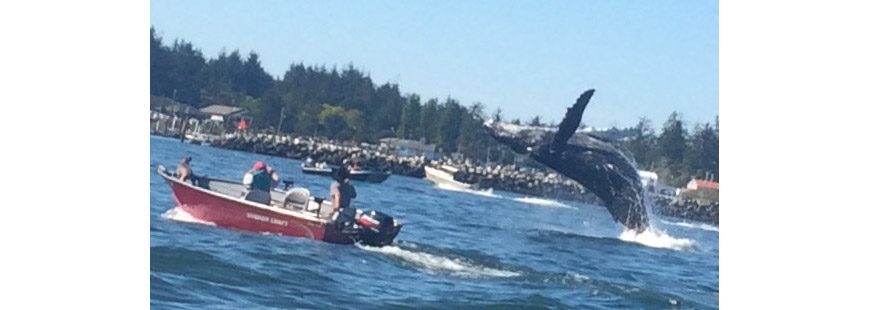Leaving Enough Baitfish in the Water
Top Photo: Humpback Whale
Often overlooked baitfish, specifically anchovies in this case, were the topic of discussion at a recent meeting in Astoria that I participated in.
A couple of commercial seine boats made a big splash in the lower Columbia River last summer. There’s no hiding it; with a spotter plane above and big seine boats operating in the estuary, an incredible harvest was taking place, but really, it’s all a matter of perspective.
The overall harvest of anchovies in the lower Columbia was relatively insignificant if you trust the numbers produced for the population estimates of the northern subpopulation (the west coast population is sub-divided into the central and northern populations). Rough estimates have the population at about 130,000 metric tons.+ The fact remains; there hasn’t been a stock assessment of the northern subpopulation for nearly a decade.
Commercial seiners on the lower Columbia took about 5,200 metric tons of a 9,750 metric ton allocation for all of Oregon and Washington. That’s less than 10% of the assumed population.
One couldn’t help notice some of the anomalies that were occurring in the lower Columbia River, however. One such phenomenon was the presence of humpback whales. Those, too, are hard to hide. What an incredible sight they provided when the fishing was slow, and it was slow a lot. It begs the question, however, why would humpback whales, typically a solitary creature, be present in fairly high abundance on the lower Columbia? Most would speculate that they didn’t have the food resources to keep them offshore in their more normal habitat. As is the case with all fisheries management, many questions remain.
Now, the Oregon Department of Fish & Wildlife is likely one of the most scrutinized agencies in the state of Oregon. I really don’t know how they pull off all of the public meetings that they do. Their outreach is quite impressive, and most Oregonians really respect the workforce at ODF&W and embrace the body of work that they do. To their credit, they seek public input on just about everything, especially when it comes to season setting. In this case, it was no different.
Sportanglers, commercial seiners, the conservation community and even the spotter pilots all came together to have a frank discussion on how this fishery was shaping up. Will it expand? How will it be regulated in the future? How can we reduce conflicts? How can we up the annual catch limits to make the fishery commercially viable? It was a good two-hour discussion and, like most meetings of this nature, had no forgone conclusion. But also like most meetings of this nature, the stakeholders cared about the resource. Of course there are fringe voices on both sides: “increase harvest opportunity” from the commercial side, and “shut it down” from the environmental side. One commercial voice stated that the sportfleet wanted to shut down all commercial fishing activities on the Columbia River, and to be fair one sportangler cried that the three-boat fleet has changed the entire dynamic of the Buoy 10 fishery, which isn’t true either. It is another clear case of communities not communicating, making assumptions and trying to solve a problem that is better suited for collaboration. For a situation like this one, it should be resolvable since it does not have a long history of contention, unlike some other long-standing commercial fisheries on the lower Columbia River.
Sportanglers are paying closer attention to ecosystem management. The worldwide trend for conserving important prey-based species such as anchovies, herring, smelt and sardines has new meaning for sportanglers as we’ve seen the average size of the salmon we’re landing dwindle in recent years. What’s really causing that? Has the ocean’s carrying capacity tapered? Are we overfishing our stocks?
Some economists are exploring the value of a ton of anchovies left in the ecosystem. The price the commercial fisherman gets for a ton of anchovies destined for the international human consumption market is shockingly low: just $200/ton! I can tell you that’s not what I pay for a pound of anchovies when I go salmon, sturgeon or tuna fishing. It’s closer to $6.50/pound! And if I’m buying canned anchovies in olive oil for my homemade Caesar salad dressing, it’s $1.79 for about 3 of those little critters. How much would our 7-pound August coho weigh if there were an additional 5,000 metric tons of anchovies left in the lower Columbia River?
Now we don’t want to stifle new markets or prevent commercial fishermen from making a living, but we do want to know that these little fish will continue to provide the ecosystem benefits that we currently enjoy. But if we’re to learn any history lessons here, it’s that stocks of fish, no matter how abundant the species, CAN be overfished, excess abundance WON’T go to waste in our ecosystems and we won’t accomplish anything meaningful unless we work together.
This fishery is somewhat contained due to market constraints and the fact it’s conducted in state waters. We’ll have bigger fish than anchovies to fry (along with a multitude of other species) when we deal with the bigger federal fisheries law, reauthorization of the Magnuson-Stevens Act. We’re really going to need a collaborative voice going forward for that conversation.


